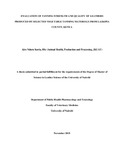| dc.description.abstract | Tanning is a processing mechanism which prevents the collagen fibrous protein in animal skins from putrefaction which lead to production of hydrothermal stable product commonly known as leather. Tannins from plants are some of the agents that are used in leather production in a process called vegetable tanning. Vegetable tanning is an ecofriendly method of tanning compared to environmental polluting chromium based method of tanning that is commonly used in commercial tanning. However vegetable tanning have not been widely used in commercial tanning because mimosa, the only available commercial vegetable tanning materials is expensive compared to chromium.
A study was conducted to determine the tanning potential of three locally available plants in Laikipia county namely: Acacia nilotica, Acacia xanthophloea and Hagenia abyssinica . The study determined the tannin content and tanning strength of the above named three plant species and their suitability for tanning hides and skins. The hide powder method was used in determining the amounts of tannins while the quality of leathers was determined by evaluating their physical properties using standard IUP methods. The leathers were produced using vegetable tanning materials from the three study plants and commercial mimosa was used as a control. The student t-test was used to compare the mean values of the tannin content and the physical properties of produced leathers.
The study found Acacia nilotica, Acacia xanthophloea and Hagenia abyssinica to contain 16.8%, 23.8%, 11.73% tannins respectively. Acacia nilotica had a tanning strength of 1.5 while Acacia xanthophloea and Hagenia abyssinica had a tanning strength of 3.3 and 2.1 respectively. There was a significant difference in the mean tannin levels between the three vegetable tanning materials identified when compared with commercial mimosa (p= 0.001).
The leathers tanned with Acacia nilotica had a tearing strength of 42.67 N, tensile strength of 28.62 N/mm2, grain crack of 7.66 mm, grain burst of 8.42 mm, endured 100,000 flexes, and shrunk at temperature of 82.50C. The leathers tanned with Acacia xanthophloea had a tearing strength of 34.92 N, tensile strength of 20.36 N/mm2, grain crack of 7.98 mm, grain burst of 8.81 mm, endured 100,000 flexes and shrunk at temperature of 850C. The leathers tanned with Hagenia abyssinica had a tearing strength of 31.25 N, tensile strength of 27.91 N/mm2, grain crack of 8.97 mm, grain burst of 9.35 mm, endured 100,000 flexes, and shrunk at temperature of 800C. The leathers tanned with commercial mimosa had a tearing strength of 34.22 N, tensile strength of 28.81 N/mm2, grain crack of 8.21 mm, grain burst of 8.76 mm, endured 100,000 flexes, and shrunk at temperature of 830C.
A comparison of physical properties of leathers tanned with materials from Acacia nilotica, Acacia xanthophloea and Hagenia abyssinica and those tanned with commercial mimosa indicated no significant difference in tensile strength, flexing endurance and tearing strength p. In addition, there was no significant difference between leathers tanned with mimosa and Acacia xanthophloea for grain crack (p= 0.67) and grain burst (p= 0.77) tests. Leather tanned with Acacia nilotica had a significant difference in grain crack (p) but no significant difference (pin grain burst when compared with mimosa. The results also indicated a significant difference on grain crack (p= 0.03) and grain burst (p= 0.02) in Hagenia abyssinica and mimosa vegetable tanned leathers.In conclusion this study found all the vegetable tanning materials tested to have more than 10% tannins and a tanning strength of more than 1.5 required for commercial extraction. The quality of leathers tanned with these vegetable tanning materials was comparable to those tanned with commercial mimosa and all of them had more than the minimum set standards. It was recommended that the selected vegetable tanning materials from Laikipia County be exploited commercially for leather production. | en_US |

